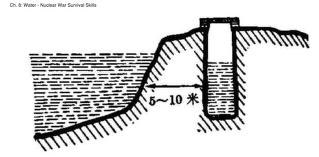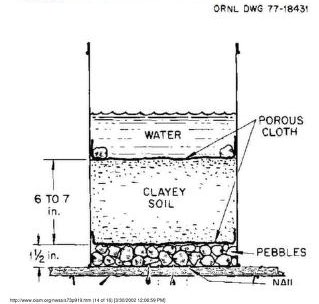Note: If you like this post, be sure and check out the first installment in the “Why every bug-out bag should have…” series Why Every Bug-Out Bag Should Have Lockpicks.
Your body can last months without food and almost a week without sleep, but you’d be lucky to make it just three days without water. Although most of the earth’s surface is covered in the stuff, only a tiny portion of it is drinkable in its current state. You can expect even less water to be drinkable after a disaster.
Here’s the bad news. Water is heavy to carry, it leaks out of the tiniest of cracks, it must be kept separate from all of your other things, and it loses all of its usefulness if dropped on the ground. Think about this; plumbing, bathing, aqueducts, and advanced farming techniques were hallmarks of great civilizations for a reason – it allowed people to worry less about drinking water and more about the big-picture. If you hope to survive the apocalypse, and keep Montezuma’s revenge at bay, then a well-thought-out water strategy is a must. Make no mistake; in the post-apocalyptic world, staying well hydrated will be your greatest survival challenge.
TIP – If you are bugging out because someone dropped the bomb, then you’re going to have to deal with radiation in the ground water and rainwater. The very well researched “Nuclear War Survival Skills” suggests running water through an earth filter made primarily of dirt (which should be extracted from several inches below the surface). This book is worth its weight in gold, and I will talk about it more deeply in a later post, because being able to assemble a radiation filter from common items like rocks, dirt, cloth, and a trashcan is exactly the kind of survival wisdom that will save your life. You will find that, and other equally important information, on every single page of this durable survival tome with the 50’s era cover.. Thanks to a generous copyright policy from the author, Oak Ridge National Laboratory, here is a diagram of the trashcan filter straight from the book:
[one_half_last]
[/one_half_last]
I highly recommend that you buy this book if you don’t already have it. This is the ultimate guide for surviving an unexpected nuclear attack. The scientists who wrote this book were actually employed by the government to do this research specifically to give Americans the best chance to survive. The text can be legally downloaded for FREE here. However, I strongly suggest you purchase the green 1999 version due to its large print and durable binding.
FYI, according to this filter manufacturer’s website, an activated charcoal/carbon filter might also be an effective way to filter out harmful radiation.
Why Every Bug-Out Bag Should Have LifeStraw
Try carrying a mere four gallons of water (which is only a couple day’s supply) and you’ll quickly see why I choose to pack several 2-ounce LifeStraws capable of filtering 264 gallons each. At just $20, it is quite a nice bargain and a great addition to your bug-out bag.
The first thing you’ll want to know is whether LifeStraw is legit. Recognized with awards from Forbes, Fortune, Newsweek, NYT, Popular Science, Readers Digest, and Time Magazine, it’s safe to assume that it’s been through the paces and isn’t snake-oil. The company is also socially conscious; for every LifeStraw retail purchased, one school child in Africa will receive safe water for a year.
There are more compact options available on Amazon that appear to more or less copy LifeStraw’s design. It seems that size is a function of capacity, so the smaller straws won’t last as long. While I can’t say for certain whether these products work as well as LifeStraw, they do seem to have a lot of satisfied customers. The ones listed below claim to improve upon the LifeStraw design by adding more filters. The SurvivalH2O straw, for example, boasts an activated carbon filter. If true, that would give it a a significant advantage over LifeStraw. On the other hand, you’d need 10 of the tiny SurvivalH2O straws to filter the 200+ gallons a single LifeStraw can filter, so the tradeoff is really about your budget.
One bonus feature all of these products have in common is how easy they are to use. In essence: you suck the water through the straw and sometimes you need to blow air through it. That’s it. How do you know the straw filter is no longer working? You wont be able to suck water through the straw anymore. It’s literally that simple.
[one_fourth]
Tiny
H2O Survival Water Filter Travel Straw
[/one_fourth][one_fourth]
Good
Personal Water Filter Straw
[/one_fourth][one_fourth]
Better
LifeStraw
[/one_fourth][one_fourth_last]
Best
The Survivor Filter
[/one_fourth_last]
TIP – For most of the water filters discussed in this article, their longevity will depend primarily on what kind of water you choose to run through them. Muddy and murky water will decrease the lifespan of a filter dramatically. That is why it is a good idea to, when possible, run your water through a makeshift filter first (clothes work) to remove the bigger chunks of debris.
Larger Filtrations Systems
To take nothing from the amazingly useful LifeStraw, it is just not a complete water solution to the long-term survivor. Sometimes, you need clean water for things other than drinking. Do you plan to suck the water through the straw and spit it out a hundred times – just to boil some noodles? Of course not. You’re going to need a standalone water purification system that allows you to fill canteens and wash wounds.
The systems below are compact, lightweight, and have great reviews. They vary vastly in price and even more so in capacity. For instance, Katadyn’s Hiking Microfilter can process 200 gallons for $53, the LifeStraw Family, for $75, will filter an incredible 4,750 gallons, and the $278 Katadyn Pocket Filter, weighing a mere 20 ounces, will filter 13,000 gallons.
Pretty amazing right? You now have the option to carry a little 20 ounce filter and get a whopping 13,000 gallons of clean water out of it. I thought was the very best choice for a survivalist until I discovered that a $22 Sawyer, which weighs 2 ounces, can filter a ridiculous 100,000 gallons! If you’re like me, your BS meter is probably going crazy right now. I felt the same way. According to this report, Messiah College ran tests on the Sawyer product and substantiated their claims. The report is conveniently hosted by Sawyer, but I have verified the link to Messiah College. The Amazon reviews are good as well. If the Sawyer mini can truly live up to those lofty claims, and I think it can, then it falls squarely into the absolute-must-have-for-every-bug-out-bag category.
[one_fourth]
Must Buy
Sawyer Products Mini Water Filtration System
[/one_fourth][one_fourth]
Good
Katadyn Hiker Microfilter
[/one_fourth][one_fourth]
Better
Lifestraw Family 1.0 Filter
[/one_fourth][one_fourth_last]
Best
Katadyn Pocket Water Microfilter
[/one_fourth_last]
Activated Charcoal & Carbon Filters
Activated charcoal (also known as activated carbon) filters often combine a porous filter with activated carbon in order to get the best of both worlds. Some harmful substances which can make it through a porous filter are neutralized by the carbon. It is also known to improve the taste of the water and, as we said earlier, can possibly remove radiation. These products provide the very best water purity and taste for the mobile survivor. Unfortunately, the charcoal filters are more limited in filtration capacity than porous filters, so these tend to lose the special benefits of a carbon filter fairly quickly.
[one_third]
Bargain
Aquamira Tactical Frontier Emergency Water Filter System
[/one_third][one_third]
Decent
Aquamira Tactical Frontier Pro Ultralight Water Filter
[/one_third][one_third_last]
Good
H2O Survival Water Filter Travel Straw
[/one_third_last]
[one_third]
Great
The Survivor Filter
[/one_third][one_third]
Better
H2O Survival Camping Water Filter
[/one_third][one_third_last]
Best
Katadyn Combi Water Microfilter
[/one_third_last]
Finding Water
Although identifying the water sources you’ll need to avoid is beyond the scope of this article, one thing is for sure; there are a hundred and one ways that groundwater can become toxic. Sure, these filters are very effective, but some types of contaminants can still make it through to hurt or even kill you. That is why I suggest that, when possible, you should avoid groundwater and collect rainwater instead to give yourself the best chance at survival.
In order to collect a good amount of rainwater, you’re going to need a large tarp. Fortunately, tarps have a wide variety of survival uses, so your bug-out bag should definitely stock at least two. To catch rainwater, the tarp should be spread out and set at an incline to funnel all the water into a receptacle. In a pinch, the tarp itself can be the receptacle. Most bug-out bags can’t fit a water tank, but you can fit a handful of heavy-duty or “contractor” trash bags. Another great item with a plethora of uses, contractor bags can hold quite a lot of water while you wait for the next rain.
[one_third]
Good
Husky 42-Gallon Contractor Bags
[/one_third][one_third]
Better
Camo 10X10 Tarp
[/one_third][one_third_last]
Best
Camo 10X7 Super Heavy-Duty Tarp
[/one_third_last]
Carrying Purified Water
A lot of people like the low cost and versatility of a good old-fashioned canteen. Can’t fault them there. It’s good to have a hard-case water carrier if possible. But there are other options that will hold more water, feel lighter, pack easier, and won’t hamper your agility. Lets talk a little about hydration bladders.
Most of these products range between 2.5 to 3 Liters in capacity and work similarly to a water bed. You just pump water into a bag and seal it off. Remember; these are not hard-case items. Although durable, you could pop the bladder if your aren’t careful.
Camelback is the leader in portable water and the reviews are glowing. Their bladders are durable, fashionable, and work as advertised. Both the Camelback and Global Sportsman bladders listed below feature backpack straps and a straw for easy access. How awesome is that?! My bug-out bag has MOLLE webbing on the outside, so I’ll also be stocking a few of these inexpensive Molle Hydration carriers to add extra water-carrying capacity.
[one_third]
Good
Molle Hydration Carrier
[/one_third][one_third]
Better
Global Sportsman Tactical Hydration Pack Backpack Carrier
[/one_third][one_third_last]
Best
CamelBak – ThermoBak 3L Hydration Pack
[/one_third_last]
Other Purification Options
There are a lot of options out there for purifying water, and the more I research, the more I find. One thing is for certain – if you can boil the water, then you should do so. Should you boil and then run your water through LifeStraw? Vice versa? Or is only one process needed? Should you add bleach to boiled water, or is that overkill? These kinds of questions still remain in my mind, and I hope to produce a more complete blog explaining the pros and cons of each system and how to use redundancy to remedy the weaknesses.
In the meantime, here are a few other options for you to look into:
Chlorine/Bleach
A few drops of household bleach added to a gallon of water will usually turn bad water into drinkable water. Check out the EPA’s fact-sheet for more information here.
Iodine Purification Tablets
Many survivalists like to carry iodine tablets to purify their water. They are light, compact, and easy to use. Much like bleach, a little bit goes a long way. Here are the top brands.
[one_third]
Good
Potable Aqua Water Purification Tablets
[/one_third][one_third]
Better
Potable Aqua Water Purification Tablets with PA Plus
[/one_third][one_third_last]
Best
Polar Pure Crystal Iodine Water Treatment
[/one_third_last]
UV Sterilization
I am skeptical that portable UV systems can be as effective as the above-mentioned techniques. In addition, most UV filters require a power source. If you are still interested, here is a link to a Military Study on the efficacy of portable UV Water Purification and a few UV filter options:
[one_half]
Smaller Waste of Money
SteriPEN Traveler Portable, Handheld UV Water Purifier
[/one_half][one_half_last]
Bigger Waste of Money
SteriPEN Handheld UV Water Purifier Classic Bundle Pack with Pre-Filter
[/one_half_last]
Desalinating Filter
There are just not a lot of good options when it comes to portable desalination. You can either pay a ton of money on a very limited Katadyn filter, or try this SeaPack thing. Either way, if you’ve got to desalinate water, portable filters are currently unable to provide a long-term solution.
[one_half]
Distilling Water
Distilling is one of the very best techniques to purify water, and is considered the number one way to desalinate. If you can properly distill your water, then you are well on your way to building your own utopia. Learn more about distilling water here.
Warning – these prefab stills, while unlikely to fit in your bug-out bag, would make an excellent addition to a bunker.
[one_half]
Slow Sand Filter
Have you got a lot of sand? Then you can probably make a decent sand filter. To learn more about slow sand filters, start here.
Bank Filtration
[one_half]The basic premise of bank filtration is simple: find a body of water and dig a well about 10 yards from the shoreline. The water will seep through the dirt into your well, losing dangerous chemicals and radiation along the way. Read more about bank filtration here.
The diagram on the right, taken from the book Nuclear War Survival Skills, shows how easy it is to make a bank filter.
[/one_half][one_half_last]

[/one_half_last]
Emergency Water Sources
Tapping Trees for Water
Some trees, like Sycamores, can provide water when you need it. Like Katniss in the Hunger Games, simply insert a spile into the tree (or cut a hole in another way) and wait for the watery sap (or sappy water) to flow. Several different kinds of trees will work, offering different levels of sweetness, but most will not. Because this is not a reliable source of water, and the water will be tainted with sap, it is best used only as a last resort. In addition, some say that packing a spile in a bug-out bag is excess luggage because a knife can accomplish the same task. I tend to agree.
For more tree-tapping info, this thread is a good place to start.
Cactus, Coconuts, and Other Water-Bearing Plants
Water-bearing plants should be used only as a last-resort to avoid dying of dehydration. Water from these sources come with severe risks attached, due to the unconventional nutrients they contain. Options to avoid death by dehydration may include bamboo shoots, banana or plantain tree trunks, green coconut milk, melted snow, cactus juice, and, strangely, drinking your own urine.
Remember never to drink salt-water as it will only make matters worse. Putting unmelted snow in your mouth is another way to go from bad to worse. In fact, any of these methods could go terribly wrong – so I suggest making yourself well aware of the risks and instructions before you try it for yourself. Here are a few links to get you started on the right track:
12 Places to find Drinking Water in an Emergency
6 Dangerous Urban Survival Myths About Water
Can You Get Potable Water From a Cactus?
Note: Did you like this post? Be sure and check out the first installment in the “Why every bug-out bag should have…” series Why Every Bug-Out Bag Should Have Lockpicks.


